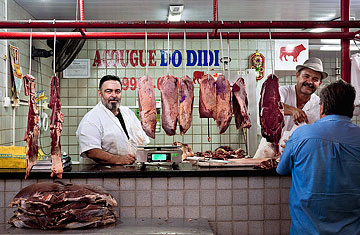
Red vs. green Rising incomes give more people a taste for meat, which is costlier to produce than vegetables
Thomas Malthus lived in an era much like today's — when emerging technologies made anything seem possible. The 19th century was approaching, the Industrial Revolution was steaming along, and in intellectual circles it was popular to believe that expanding scientific knowledge could create a more enlightened, even utopian, society.
Malthus, however, was making a more dire calculation. In 1798 he published An Essay on the Principle of Population, whose grim vision of the future haunts mankind to this day. Malthus thought we could never overcome two basic laws of nature: the planet's population grows exponentially, while food production increases arithmetically. Therefore the planet will become short on food. "The power of population is indefinitely greater than the power in the earth to produce subsistence for man," he contended. The "natural inequality" between these two forces "appears insurmountable in the way to the perfectibility of society." Inevitably, the result would be "misery and vice."
Taking a look around us today, it would be easy to conclude that Malthus was prescient. Food prices are near historic highs, driven upward by an ever larger, ever hungrier population. Every report of drought or flooding raises fears of global shortages. About 925 million people go to bed hungry every night. And every day we add 219,000 mouths to feed, while the land, water and other resources needed to produce additional food edge closer to their apparent limits. This intensifying "natural inequality" leaves some experts sounding like modern-day Malthuses. "No civilization has ever survived the ongoing destruction of its natural support system," says Lester Brown, president of the Earth Policy Institute. "And neither will ours."
So was Malthus right? Not exactly. Even though the world's population has increased about sevenfold since his time, food production has more or less kept pace, at least enough that we don't suffer mass starvation. (Millions have starved for political reasons.) Nevertheless, the global food industry is at a crucial point. In the 2010-11 season, we consumed more grain than we produced, and food prices rose dramatically as a result. Globally, food costs 39% more today than just a year ago, according to the U.N.'s Food and Agriculture Organization (FAO). Grain reserves are in decline relative to our needs.
Yes, last year's global harvest was reduced by bad weather, but the problem isn't going away. Deep historical trends — the shift of economic power from West to East and the quest for new, cleaner sources of energy — are permanently reshaping the way the world consumes food. The FAO projects that food production must increase 70% by 2050 to meet the growing demand of an expanding population. Ensuring that we have sufficient food at prices we can afford is one of the most pressing and potentially volatile issues facing the global community. "The world really has to sit up and pay attention," says Ngozi Okonjo-Iweala, a managing director of the World Bank. "The food security problem is a global security problem."
Seeds of Disaster
Ironically, the roots of our food crisis lie in what is otherwise a great leap forward for humanity: the alleviation of poverty in the developing world. As the poor in China, India and other emerging economies escape destitution, they can afford to load up their plates more than ever. Grain consumption in the developing world has increased 80% over the past 30 years, compared with a rise of only 22% in the advanced economies. And, more important, the nouveaux riches of Beijing and Rio de Janeiro are changing their diets, adding more meat and other luxuries that were once out of their financial reach.
The amount of meat each person consumes has doubled over the past three decades. That puts extra pressure on agriculture. To raise enough cows and pigs to supply the steaks and chops people demand, corn and other grains are diverted from people to animals. On a U.S. feedlot, it can take about 6 kilos of grain to produce 1 kilo of beef, plus thousands of liters of water. Adding to the increased demand for corn is the growing popularity of biofuels. In 2000 only 6% of America's corn harvest was used to manufacture ethanol; now about 40% is — enough to feed at least 350 million people, according to the Earth Policy Institute.
